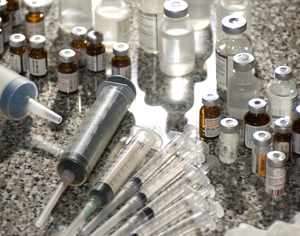Your trainer meets you at the out-gate and starts to critique your round as you hop off your horse. That’s when a total stranger walks up and says, “Hi. I’m with the U.S. Equestrian Federation, and your horse has been selected for testing.”

If you’re like 99 percent of horse-show competitors, you don’t dope your horse. But you can’t help gulping when you hear those words?it’s like being called to the principal’s office in junior high. Did you or your trainer make a mistake? Are you in trouble?
The USEF regulations for drugs and medications can seem complicated, and changes this year may affect you. In this article Stephen Schumacher, DVM, chief administrator of the USEF Equine Drugs and Medications Program, explains the changes and tells you how to make sure you stay on the right side of the rules.
The goal of the USEF program is to protect horses from abuse and maintain a level playing field, so no competitor gains an unfair advantage through chemistry. And it’s working, Dr. Schumacher says. Of the 10,000 to 12,000 horses that the USEF tests annually (not a huge number, considering how often horses compete and the number of disciplines that the federation oversees), anywhere from 50 to 100 may test positive in a given year?1 percent or less.
“The low rate of positives doesn’t mean the program isn’t needed,” Dr. Schumacher says. “The numbers are low because the program is there?deterrence is its main effect. We would rather educate than adjudicate.”
Education starts with understanding what is and isn’t legal. It’s all spelled out in the USEF Rule Book.
Read All About It
General rules 401 through 413 outline the procedures for testing and enforcement and explain in general what is and isn’t permitted. These rules are carefully (and sometimes densely) worded but definitely worth the read. Anyone who signs an entry form at a USEF-recognized show needs to understand them because that person (usually the trainer, acting as the agent of the owner) has the primary responsibility for making sure the rules are followed. The separate “2012 Guidelines for Drugs and Medications,” available on the USEF website or in a pamphlet from the federation, provide a roadmap for staying out of trouble.
The rules allow different breeds and divisions to adopt different standards for permitted medications; endurance horses, for example, are subject to strict “no foreign substances” requirements. Here we’ll focus on the rules and guidelines that apply to hunter, jumper, eventing and dressage ?divisions. These rules don’t give you a list of every substance that is and isn’t allowed, although they do mention some specifics. New drugs are always being developed, and there will always be a few people willing to try new ways to gain an advantage.
To cover all cases, the rules classify substances based on their actions and uses. Permitted substances, which are not regulated by USEF, include vitamins, minerals, electrolytes, dewormers and most antibiotics (except procaine penicillin?penicillin is OK, but procaine is a local anesthetic that can linger in the horse’s system). They can be given to a horse at any time, including at a competition. Other drugs are sorted into two groups, restricted and forbidden.
Restricted Substances
These drugs can be used for therapeutic reasons?that is, to treat an injury or disease?but they’re subject to strict limits on the amount of the drug or its metabolites (breakdown products) that can be in blood or urine at the time of competition, as set out in Rule 410. They include the muscle relaxant methocarbamol (Robaxin), the corticosteroid dexamethasone (Azium) and seven nonsteroidal anti-inflammatory drugs: phenylbutazone, flunixin meglumine (Banamine), ketoprofen (Ketofen), meclofenamic acid (Arquel), naproxen (Equiproxen), diclofenac (Surpass, a topical) and firocoxib (Equioxx). Theobromine, a metabolite of caffeine and related substances, is also in this category; the limit is just enough to account for any the horse might get through diet.
You should know:
- The “2012 Guidelines for Drugs and Medications” provide detection times for restricted substances, to help you judge when blood and urine levels are likely to be within legal limits. For example, if your horse breaks out in hives and you give him oral dexamethasone at the dosage listed in the guidelines, his blood levels should be OK in six hours.
- The times listed in the guidelines are recommendations, not rules, and the drug clearance times vary with dosage rates, the form of the drug and how it’s delivered. If your horse tests over the limit, he’s in violation whether or not you followed the guidelines.
- Compounded medications (made up to order by compounding pharmacies) call for special care because ingredients may vary more than they do in manufactured drugs.
New this year:
- Only one NSAID can be present in a sample; previously the rules allowed two. “This is probably the most significant change this year,” Dr. Schumacher says. The change, which took effect December 1, 2011, was made to end the potentially harmful practice of “stacking” these drugs.
- With just one NSAID allowed, detection times have been reduced from seven days to 72 hours for these drugs. If your horse has been getting two NSAIDs, you need to stop one of them at least 72 hours before competing. Only one can be administered in the 72 hours before a competition, and that one must be within the limits set by the rules.
- Although only one NSAID is allowed, there’s a new emergency provision for therapeutic use of Banamine (flunixin meglumine) for colic or eye problems, conditions for which this drug is particularly helpful. Suppose your horse was given phenylbutazone before a competition and you stopped the drug to allow for the recommended withdrawal time. Then, at the show, he colics. Under the new rule, he can have Banamine?a single dose, limited quantity?and return to competition in 24 hours. “Under the old rules he couldn’t have Banamine unless he waited seven days to compete, so the change is an improvement.” Schumacher says. “The caveat is that you must have a veterinarian administer the drug and submit a medication report to show officials.”
Forbidden Substances
These are drugs that can affect performance, give an unfair advantage, pose a danger to your horse or interfere with drug testing by masking the presence of other drugs. They include stimulants, ?depressants, painkillers and local anesthetics, and tranquilizers and psychotropic drugs, such as reserpine and fluphenazine. Prednisolone, bethamethasone, triamcinolone acetate (Vetalog, often used in joint injections) and other corticosteroids except dexamethasone are in this category. So are NSAIDs other than the seven listed in the restricted group. Although many of these drugs have legitimate therapeutic uses, they should not turn up in a horse-show drug test.
You should know:
- Some of these drugs can still be ?detected weeks after the last dose; reserpine and fluphenazine can persist for 90 days. The guidelines list detection times for a number of the drugs, and the USEF Equine Drugs and Medications Department can provide times for more.
- Herbal and other supplements sometimes lead to positive drug tests, so be sure you know what’s in a product ?before you feed it to your horse. ?”Natural” doesn’t mean drug-free?plants are the source of many potent drugs, and some can produce metabolites like those of forbidden substances. For ?example, the herb rauwolfia (Indian snakeroot) is the source of reserpine.
New this year:
- USEF has changed the way it handles some forbidden-substance violations in the eight disciplines governed by the ?International Equestrian Association (FEI), including dressage, eventing and show jumping. See the box on page 57 for more about this change.
- Anabolic steroids have been added to the “forbidden” list for all USEF disciplines; previously they were banned only in some halter divisions for Arabians, Half-Arabians and Anglo-Arabians. These drugs have therapeutic uses?they can help in recovery from colic surgery and in cases of muscle wasting, for example?but they’ve been widely misused in race training as a short-cut to building muscle mass and stamina in young horses. They’re not widely used in sporthorses, according to Dr. Schumacher, because such shortcuts aren’t needed, and the drugs can produce undesirable behavior.
“We’ve run surveillance across the ?disciplines and never had an issue with anabolic steroids. But we’ve made them forbidden and provided withdrawal guidelines for the most commonly used ones to recognize their potential for ?unfair use and to be consistent with other groups,” he says. “We are actually the last horse-sport group to abolish their use in competition.”
Bending the Rules
The USEF rules are clear: If you give your horse something to calm him or make him less sore in competition, you’re in violation?even if the same something might be permitted for a legitimate therapeutic reason. But intent can be hard to judge, so it’s not always clear when someone steps over the line.
For example, you might see dexamethasone in horse-show medicine chests. Some competitors administer “dex” in the belief that it will calm a nervous horse, although the rules expressly forbid that use and there’s not much evidence that it works.
“Based on work done years ago, the level permitted under the rules would not be expected to sedate a horse,” Dr. Schumacher says. “Some people feel differently. I don’t think there’s any peer-reviewed scientific literature to support that, but there’s a racetrack mentality?people think it works so they use it.” The USEF Drugs and Medications committee will likely be reviewing the guidelines and recommendations for dex, he adds.
Magnesium is also used to quiet horses, something that Dr. Schumacher says is based on a misconception. ?”Hyperexcitability is a sign of hypomagnesia?magnesium deficiency?and giving therapeutic doses of magnesium corrects it. Based on that, some people conclude that giving any horse more magnesium will make him calmer even if he isn’t deficient, but there’s no evidence for that,” he says. Even if it were so, oral magnesium is not a concern because it’s unlikely that a horse could consume enough orally to be affected, he notes. But some competitors administer magnesium sulfate intravenously, which is dangerous. “Given this way, magnesium can affect cardiac rhythm and have a depressant effect, and it’s a horse-welfare issue,” he says.
As of this writing, USEF had no prohibition on magnesium, although the substance is on the association’s radar. One problem is that magnesium is naturally present in horses and in all animals. “To regulate it, you first have to establish a threshold level that’s acceptable. It’s a different situation with drugs like NSAIDs that aren’t naturally present,” Dr. Schumacher says. Nevertheless, he adds, injected magnesium sulfate has been added to the FEI prohibited list this year, and administration will no longer be permitted at FEI show treatment areas.
If Your Horse Is Tested
How likely is your horse to be tested? The choice is pretty much random. “We test at 20 to 25 percent of competitions each year,” Dr. Schumacher says. “There is a focus on upper levels, where more is at stake and violations may be more likely to occur, but we test lower levels as well.” He selects the shows and then asks one of the veterinarians who works with the program to test perhaps one day out of four, at his or her convenience. The odds of being tested are greater for horses who display unusual behavior or place in the top five of their classes, but anyone can be selected. For example, in a dressage class, horses are picked randomly as they leave the ring before the placings are decided.
If your horse is tapped, be polite and take him promptly to the testing area. Arguing or stalling (by cooling out, bandaging and other delays) may be considered “noncooperation,” as much a violation as a positive test. Be helpful as the veterinarian draws blood and the technician working with the vet collects a urine sample.
The samples are handled according to standards set by the World Anti-Doping Agency. Both blood and urine are separated into A and B samples; the A samples are sent to the designated USEF lab for testing, and the B samples are held. If the A samples test clean, the B samples are discarded. But if the test is positive, the trainer (or whomever is responsible) has the right to have the B sample tested to confirm or disprove the result.
A positive test leads to an investigation and a decision on whether the rules were violated. The trainer usually has the choice of accepting an administrative penalty or responding at a hearing before a USEF committee, with or without legal representation. If the committee finds a violation occurred, it will weigh several factors?the type and (for drugs covered by Rule 410) the quantity of drug found, prior violations and how similar cases have been handled. Violators forfeit winnings and any points earned, and under USEF rules they face penalties that include fines ($750 to $5,000) and suspension (one to six months). The violation and the penalty are published, in itself a strong deterrent.
There are trends in violations, Dr. Schumacher says, like a recent spike in reserpine positives. “Medications pop up, but after a few positives, word gets around and the use tails off,” he says. Still, the most common violations ?involve NSAID levels over the limits set by the rules.
“These are ?speeding ticket’ violations, not as serious as, say, doping the horse with an antipsychotic medication,” Dr. Schumacher says. “In most cases we can identify the reason for the violation, and it’s a mistake. Maybe a groom dosed the horse, and the trainer was unaware and gave a second dose.”
To guard against such mistakes, he suggests, make sure your horse’s treatment program is secure, defined and documented:
- Lock up medications and restrict access to them, at home and at shows.
- Be sure only designated people (for safety, just one person at a competition) can give medications to your horse.
- Write down the treatment program and document every dose.
- Clean out the feed buckets (they could harbor traces of medications or supplements), and don’t swap buckets among horses.
Last fall, the American Association of Equine Practitioners published a set of guidelines for veterinarians treating nonracing performance horses, and they included several tips that may also help you stay out of trouble:
- No medication should be administered to a horse within 12 hours of a competition.
- Nontherapeutic or nonprescribed medications or substances should not be administered to performance horses by anyone.
Maybe some competitors will always be ready to bend the rules (or ignore accepted ethics), even when doing so puts a horse’s health at risk. But statistics suggest these folks are a very small minority. Care and common sense will keep you out of their group.
This article originally appeared in the April 2012 issue of Practical Horseman magazine.









